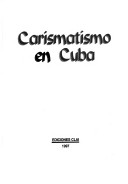Carismatismo en Cuba, reviewed by Francisco Arriola
 Reinerio Arce, Manuel Quintero and Elizabeth Carrillo, eds., Carismatismo en Cuba (Quito, Ecuador: CLAI, 1997).
Reinerio Arce, Manuel Quintero and Elizabeth Carrillo, eds., Carismatismo en Cuba (Quito, Ecuador: CLAI, 1997).
This book is made up eight essays written by Cuban clergy and university faculty, which provide a panoramic view of the Pentecostal/charismatic movement inside Cuba. Six of the essays provide us with the understanding that in spite of forty years of communist rule the Pentecostal/charismatic movement is alive and well in Cuba. This is further supported by the excellent interviews with a Catholic layperson, a Methodist minister and Pentecostal pastor found at the end of the book. The remaining two essays address the doctrine of Spirit baptism and the creative and renewing work of the Spirit.
In keeping with the intense missionary emphasis of the early Pentecostal movement, various denominations established churches in the Cuba at the beginning of the 20th century. Many of the major North American denominations such as Open Bible Churches, Church of God, Assemblies of God and the Foursquare Church established churches throughout the island.1 The first major period of Pentecostal expansion (1930-1960) was due to widespread temple building, public evangelistic and healing services. It was during this period that many Cuban Pentecostals leaders separated from their parent churches to establish their own denominations. During the 1970s and 1980s the difficulties brought about the Communist government led to a decline in membership and the inability to educate leaders. There was, however, the continued establishment of Cuban national Pentecostal churches.
From the late 1980s, till present, Pentecostalism in Cuba has seen a revitalization and increase in its membership. The disillusionment experienced by the Cuban people with the atheistic and materialistic Communist government has led many to seek spiritual answers to life’s problems. The churches during this period have had some success in establishing positive relationships with the government.
Cuban Pentecostalism shares many of the doctrinal and liturgical emphases found in Pentecostalism throughout the world. Its doctrines of salvation, baptism in the Holy Spirit, speaking in tongues and healing are similar to what is found in most Pentecostal churches internationally. Its worship services, which follow an informal liturgical program, are open to spontaneity and the participation of members through public prayer and testimonies. It is this freedom of expression within the worship service that attracts new converts.
The influences of modern society have made inroads in Cuban Pentecostalism, which is seen in the adaptation of modern dress, and activities once prohibited such as mixed bathing (swimming). Cuban Pentecostals are also involved in many ecumenical organizations within Cuba, Latin America, and beyond. The essays also point out the interest shared by Pentecostals and Charismatics about the social and political implications of the gospel message for Cuban society.
Category: Church History, Fall 2002


